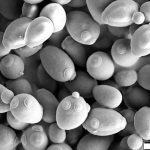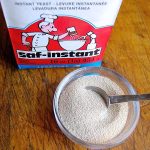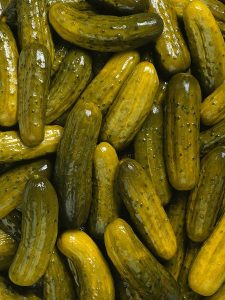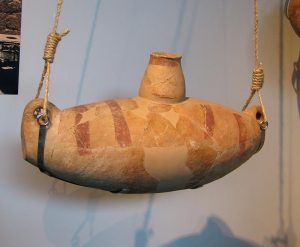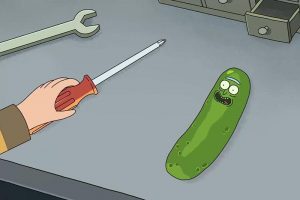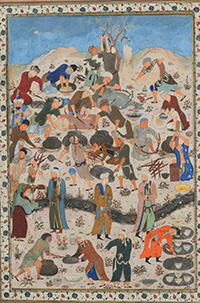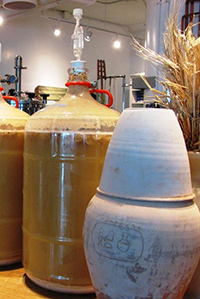

July 2020
Vol. 8, No. 7
Pickles and Prehistory
By Alex Joffe
Yeast is having a rare cultural moment. The mysterious yet omnipresent material flew off the shelves as millions rushed to bake their own bread during the recent quarantines, albeit with uneven success.
But yeast (usually taken to mean the fungus Saccharomyces) has been with us for a while, working its magic quietly, alongside even smaller and quieter agents, namely lactobacilli and acetobacter. In the past few years archaeologists have turned their attention to these unsung heroes. Several recent breakthroughs, and one offhand comment, have given me pause.
One was the baking of bread using yeast isolated from ceramics dating to the Old Kingdom. Another was the recreation of several forms of beer brewed during the Early Bronze and Iron Ages. In an interview about this remarkable technical achievement, Professor Aren Maeir, one of the principal investigators, added “This could open up an entirely new field of identifying and rediscovering organisms, like ancient pickles, wine and cheese.”
Now I’m not sure whether Aren was referring to the process of pickling, which is the process of preserving food by immersion in brine or vinegar, or actual pickles made of cucumbers. I should explain that I have a longstanding interest in these matters.
Almost 25 years ago I wrote what turned out to be a surprisingly popular paper on wine and beer in early complex societies. In that paper, which dealt primarily with the evidence for early states provisioning workers with beer and for trade in wine, I completely neglected the role of vinegar.
Vinegar is produced by the fermentation of almost any carbohydrate source into acetic acid by acetobacter, a common environmental bacterium found in soils and in association with plants. Carbohydrate sources include grapes and wine, dates, berries, honey, melons, grains, beets, whey and much more. Vinegar has all sorts of useful and healthy properties; it is antibacterial and therefore acts as a preservative, has B vitamins, and lowers blood glucose. It may even lower cholesterol and help you lose weight. And of course it is a critical part of salad dressing. Today vinegar is produced by industrial means, but historically it was a naturally occurring process. But was it wanted or unwanted?
Humans have been making alcoholic beverages for at least ten thousand years, pursuing the twin goals of liquid nutrition and a tasty buzz. Beer and wine gets most of the attention, but other fruits like figs and dates (and date sap) not to mention palm sap can be fermented into beverages, and even distilled into spirits. Ciders made from fruit like apples and pears also deserve to be mentioned. All of these fruits also produce vinegars.
Back then I was more interested in the idea that ancient Egyptians who built the pyramids were paid in liquid bread than the idea of preserving vegetables and other foods with vinegar. More recently, in Aren’s festschrift actually, I wrote about foods and foodways in the Early Bronze Age and what they suggest about the structure of society. I mentioned vinegar, but not pickles or pickling as such.
Were there actual pickles in the ancient Near East? This is a problem. One of the most influential pieces of evidence is Numbers 11:5, which states:
We remember the fish that we used to eat free in Egypt, the cucumbers, the melons, the leeks, the onions, and the garlic.
The Hebrew word הַקִּשֻּׁאִים is uniformly translated as cucumbers. The root קִשֻּׁאָה is presumably related to the Akkadian word ḳiššû. This seems to mean a member of the genus Cucurbitaceae, which includes melons, gourds, and cucumbers. Since Numbers 11:5 already used a fairly unambiguous term for melons (הָֽאֲבַטִּחִ֔ים), and since the book of Jonah uses another word for gourd (קִּֽיקָי֖וֹן), I presume Biblical translators went straight down the list to cucumbers.
The problem is that cucumbers (Cucumis sativus) originated in India and did not reach the ancient Near East until the Roman period. A careful study of the imagery and terminology associated with cucumbers demonstrates that ancient sources including the Bible were describing various types of melons, specifically Cucumis melo, the muskmelon, whose most famous cultivars include cantaloupe and honeydew.
So if there were no pickles in the ancient Near East before the Romans, what about pickling? There are two basic materials used in pickling, salt and vinegar. After simple dehydration, salting to draw out moisture and cure food is one of the earliest and simplest forms of preservation, but precisely when brining (anaerobic fermentation) was introduced is unknown. But vinegar was an unavoidable (and possibly large scale) byproduct of grape cultivation and wine production that began in the middle Holocene. Maybe we are missing a pickle revolution in the ancient Near East based on vinegar and all types of fermentation that fundamentally changed food production, preservation, and consumption from the Neolithic (?) period onward.
Of course, there are other means to prepare and preserve food, namely drying and smoking. Fish and presumably meat were smoked in Mesopotamia and Egypt but to my knowledge there is no direct archaeological evidence of smoking or drying installations or from food remains themselves. Drying facilities would have been quite ephemeral while smokehouses of any size would probably have been located outside of settlements. They probably would have looked like a shed or a storehouse that smelled delicious. Fatty smokiness residues might be the only way to distinguish an ancient smoke house from a malt house, where grain for beer or whiskey is soaked, then germinated, and then dried before distillation.
Having once built a smoker out of two large flowerpots I also imagine that the ubiquitous baking ovens could have been used to smoke food, provided it could be done low and slow, with the heat controlled and the smoke contained. Trace element analysis of fatty residues from the ceramic of ancient ovens might indicate what else was been prepared in them besides bread. Bronze Age brisket anyone? Similar analyses of food preparation and storage pots might indicate whether meats were being preserved with salty brine or with vinegar. Distinguishing ancient pastrami from corned beef should be an important goal for future research and of course, experimentation.
Pickled fish, birds, and of course fruits and vegetables are much more likely. The Talmud mentions fish pickled in vinegar dozens of times, along with many fruits and vegetables, including olives. Even today on Cyprus, despite the practice having been outlawed, migrating songbirds are trapped, pickled and eaten whole, a dish called Ambelopoulia.
Many cultures also rely on different forms of fermentation to create foods or for food preservation. Sourdough bread is made by naturally occurring wild yeast and lactobacilli fermenting dough. Kimchi is a traditional Korean dish of cabbage or other vegetables made in a fermentation pot. Lactobacilli again do the fermenting, as they do with yogurt, a term which may be derived from the Turkish word “yoğurmak,” meaning to thicken, coagulate, or curdle. Laban and kefir are fermented milk products where yeast and bacteria break down lactose sugar into lactic acids.
Cheese requires acidification or souring with vinegar, naturally with lactobacilli, and then usually the addition of rennet, an enzyme from ruminant stomachs, although plants like thistles and capers also coagulate milk. Middle Eastern cuisine has other dishes including kishk, a combination of cooked and dried grains and dry fermented milks, as well as fermented milk and bread products.
But various condiments also rely on fermentation. Gochujang is a Korean fermented red chili paste that is traditionally made in a ceramic pot and placed outside on a well-lit and well-ventilated terrace called a Jangdokdae.
Soy sauce is a fermented soybean paste made with grain, brine and various yeasts and molds, which traditionally takes months to make. And best of all, Marmite, the world’s most delicious condiment, is made from concentrated brewer’s yeast, salt, and a secret blend of spices.
A pickle revolution based on fermentation would have been a greater social innovation than large-scale viticulture for wine. Large-scale production of vinegar in particular would have facilitated a revolution in food preservation and storage, changing the cycle of the year and driving new investments in sedentary life, material culture, and changing conceptions of time.

The ginger beer was bottled shortly after this photograph was taken. It was disappointingly flat. The giardiniera was transferred to smaller containers and was delightfully crunchy. The sourdough starter stank up the kitchen but ended up in bread, pancakes, and pizza. Photo by the author.
Pickled onions take only a few hours and milk ferments over night, but dill pickles take at least a week, as do pickled walnuts, while sauerkraut can take two months or more. The world’s oldest sourdough starter is reputed to be around 120 years old, conservation of which required a considerable amount of thought on the part of four successive generations of the same family.
The grape’s delicious associate, the olive, was also domesticated in late prehistory. But the fruit is inedible without prolonged soaking in water followed by curing in brine or vinegar (plan on at least a week for each stage). Maybe they even used lye (sodium hydroxide, now used for lutefisk, bagels, soap and drain cleaner, and traditionally made from leached wood ashes), but I’m guessing not because of the huge amount of rinsing involved. Either way, the resulting fermented fruits could last for a year or even longer.
All fermented foods can be stored – at the right temperatures – for months if not more, making complex annual schedules possible only based on localism. In fact, I suspect that it was the fermenting of enough foods that made sedentism – staying in one place across all the seasons – possible in the first place, and possibly agriculture as well. These may only have been possible by cycling enough storable foods through fermentation. That comes with a cost; pickle jars are hard to transport, especially if they’re full. So if you’ve got to run, just grab the sourdough starter and maybe the vinegar culture.
Fermentation also brought new forms of food and associated social behaviors, not least of all hoisting a pint. There would have been impacts not only on health and nutrition but also medicine (Hippocrates prescribed vinegar), gender roles (who makes the yogurt/beer/kimchi anyway?), and much more.
Social groups would have had to adapt to new foods and create new behaviors, like expressing identities through specific foods and preparation methods (think regional barbeque sauces), and pooling labor to create scaled production and mitigate community risk by building shared facilities like breweries. In turn, these would have given the enterprising folks new opportunities to take leadership roles and monopolize production of commodities. And all this would have driven new shapes and types of ceramics, their production and trade. Pickling may thus help answer the age-old archaeological question, why did they have so many pots? Maybe they weren’t ‘storage jars,’ they were crocks.
In a 1779 letter to the Abbé Morellet, Benjamin Franklin commented “Behold the rain which descend from heaven upon our vineyards, and which incorporates itself with the grapes, to be changed into wine; a constant proof that God loves us, and loves to see us happy.” No, he didn’t talk about beer, but his praise must be extended to that which has been pickled and otherwise fermented.* Now with techniques to isolate yeast and other organic residues including perhaps bacterial DNA from within ceramics we may be finally be able to determine the fundamental role of pickles and fermentation in civilization. Now that’s the best tastin’ pickle I ever ‘hoid.
Alex Joffe is the editor of The Ancient Near East Today.
*In his p.s., Franklin, the wisest of all Americans, added an important biomechanical insight:
To confirm still more your piety and gratitude to Divine Providence, reflect upon the situation which it has given to the elbow. You see in animals, who are intended to drink the waters that flow upon the earth, that if they have long legs, they also have a long neck, so that they can get at their drink without kneeling down. But man, who was destined to drink wine, is framed in a manner that he may raise the glass to his mouth. If the elbow had been placed nearer the mouth, the part in advance would have been too short to bring the glass up to the mouth; and if had been nearer the shoulder that part would have been so long that when it attempted to carry the wine to the mouth it would have overshot the mark and gone beyond the head; thus, either way, we should been in the case of Tantalus. But from the actual situation of the elbow, we are enabled to drink at our ease, the glass going directly to the mouth. Let us, then, with glass in hand, adore this benevolent wisdom; -let us adore and drink!
Want To Learn More?
 Potent Potables of the Past: Beer and Brewing in Mesopotamia
Potent Potables of the Past: Beer and Brewing in Mesopotamia
By Tate Paulette and Michael Fisher
In ancient Mesopotamia, people knew how to appreciate a good beer. They appreciated their beer often and often in large quantities. They sang songs and wrote poetry about beer. Sometimes they got drunk and threw caution to the wind. Read More
 Arabic Medieval Cookbooks in English Translation: Treasure Troves for Near Eastern Material Culture
Arabic Medieval Cookbooks in English Translation: Treasure Troves for Near Eastern Material Culture
By Nawal Nasrallah
Medieval cookbooks present hundreds of recipes, including a surprising number for sparrow. But they tell us much more than about food; they provide a picture of life and manners. Read More
A Toast to Our Fermented Past: Case Studies in the Experimental Archaeology of Alcoholic Beverages
By Kevin M. Cullen
Archaeologists and historians are constantly in pursuit of the tangible human past, whether it is in the form of material culture or primary written sources. This direct evidence of the past can still leave us disconnected from the full context in which the technology or writings were employed. Therefore, one exciting field of research is experimental archaeology, in which the past literally comes alive though the step-by-step recreation process of an ancient technology, method, or even recipe…Read More
